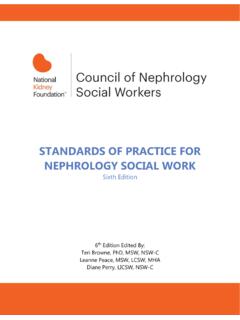Transcription of Clinical leadership – a framework for action
1 Clinical leadership a framework for action A guide for senior leaders on developing professional diversity at board level We are pleased to say this framework document has been endorsed by: We support providers to give patients safe, high quality, compassionate care within local health systems that are financially sustainable. A new framework for action on Clinical leadership Building confidence Widening perspectives Talent management Practical levers Organisational culture 1 | Clinical leadership a framework for action Contents 1. Introduction .. 2 2. How to use this guide .. 4 3. What do we mean by Clinical leadership ? .. 5 4. What are the legal or policy considerations? .. 7 5. The framework for action .. 9 6. Next steps .. 17 Annex 1: Key questions .. 18 Annex 2: Useful resources.
2 19 Annex 3: Development team .. 21 Annex 4: References .. 22 2 | Clinical leadership a framework for action 1. Introduction This guide addresses The NHS Long Term Plan1 priority around nurturing the next generation of leaders and supporting all those with the capability and ambition to reach the most senior levels of the service. It was developed in response to the 2018 recommendations to the Secretary of State for Health and social Care to ensure more clinicians from all professional backgrounds take on strategic leadership It is also an invitation to start new conversations about Clinical leadership in organisations at all levels, and to share that learning with colleagues, between organisations and with NHS Improvement and NHS England. Please email us with your responses at or via the Improvement Hub.
3 At the most senior levels of healthcare organisations, leaders face increasingly complex strategic and operational problems arising from the demands of an ageing population, shortages in key workforce groups and ongoing financial constraint. These challenges demand: effective team-based working within and across traditional organisational and sector boundaries innovation and experimentation to find new ways of delivering care collaborative and compassionate leadership to enable health and care staff to do their best work. Evidence suggests that professionally diverse teams3,4,5 and clinicians at board level6,7 increase the likelihood of meeting these challenges. Drawing on this, the NHS Long Term Plan highlights the importance of visible senior Clinical leadership in enabling and assuring the delivery of high quality care, both within organisations and in the new system architecture.
4 3 | Clinical leadership a framework for action Building on Clinical leadership work by professional and national NHS bodies, NHS England, NHS Improvement, NHS leadership Academy and NHS Providers are working together to respond to the 2018 recommendations. Our particular focus is increasing the number of people with Clinical backgrounds involved in strategic leadership . Traditionally, doctors and nurses have a seat at the provider board table. However, there are a host of other clinicians allied health professionals (AHPs), pharmacists, healthcare scientists, midwives, psychologists who also have great leadership contributions to make but, because of career structures or expectations, may be less able to find their way to strategic roles that maximise their contribution. Clinicians from all professional backgrounds have a lot to offer as senior leaders.
5 Supporting these talented people, who are already working in our organisations, to make the most of their potential is an opportunity too important to neglect. Dido Harding, Chair, NHS Improvement We hope this guide helps senior leaders recognise that all professions can provide high calibre candidates for senior roles particular when new senior teams are coming together to lead integrated care systems as part of delivering the Long Term Plan. We also hope it shows future leaders with Clinical backgrounds what their journeys to senior positions could be like. We are pleased to say this guide has been endorsed by: Academy for Healthcare Science Academy of Medical Royal Colleges Allied Health Professions Federation Association of Clinical Psychologists CIC Faculty of Medical leadership and Management The British Psychological Society The Royal College of Midwives The Royal College of Nursing The Royal Pharmaceutical Society 4 | Clinical leadership a framework for action 2.
6 How to use this guide Our work shows that organisations and circumstances are too different from each other for it to be possible to prescribe high impact actions with a promise that they will make a difference in all cases. Much of what succeeds in one context will be down to a passionate leader, a history of success, or even a significant failure that sparked new interest in Clinical leadership . We have tried instead to set out the range of barriers our work suggests can hamper people with Clinical backgrounds in gaining senior roles, along with examples of how these have been overcome. Although, of course, there are differences by profession, we were surprised to find there were many more similarities. We also came across organisations and individuals tackling these barriers in innovative ways.
7 This guide therefore contains: Key questions for chairs, chief executives and senior leaders about common barriers to clinicians taking part in senior organisational management. In naming these, we hope leaders working to increase the professional diversity of their teams will gain new perspectives. These questions appear throughout the guide and are listed in Annex 1. Vignettes of how people are already tackling these issues in innovative ways, which link to detailed case studies. We hope these will provide new ideas for leaders and aspiring leaders about what their leadership journeys could be like. Approach In creating this guide, we modelled the good practice we are suggesting, bringing together a professionally diverse stakeholder group and together carrying out the reviews, scoping, analysis and sourcing of case studies.
8 Group members represented a range of Clinical and non- Clinical professions, which meant we were easily able to access a wider network of stakeholders. Though it was not always easy, working together and keeping our shared goals in mind, we were able to bring ideas and to challenge each other constructively. Further information is provided in Annex 4. 5 | Clinical leadership a framework for action 3. What do we mean by Clinical leadership ? What we mean by Clinical In a changing service landscape, the term Clinical can be ambiguous: narrowly defined as traditional NHS Clinical professions or widely defined as anyone trained to deliver frontline care. As this guide is primarily for NHS organisations, we have started with Clinical professions in health: allied health professionals (AHPs) 1 doctors healthcare scientists (HCS) 2 midwives nurses pharmacists psychologists social workers.
9 We have included social workers in our definition because, as the Long Term Plan signals, frontline health and care professionals will be working together more and more in all aspects of the system. We acknowledge that we have less information about this profession at this stage, so we invite people with experience from a social work perspective, particularly recognising the strong history of joint work between health and social care in the mental health sector, to get in touch and add to our bank of case studies. The list above is also not exhaustive the information is intended to support all professions. 1 AHPs include art therapists, drama therapists, music therapists, chiropodists/podiatrists, dietitians, occupational therapists, operating department practitioners, orthoptists, osteopaths, paramedics, physiotherapists, prosthetists and orthotists, radiographers and speech and language therapists.
10 Find out more at: 2 Healthcare scientists include biomedical scientists and Clinical scientists. Find out more at: 6 | Clinical leadership a framework for action What we mean by Clinical leadership Clinical leadership can mean different things in different contexts. These meanings are often conflated, which can make participating in senior organisational management more difficult for people with Clinical backgrounds. One common use is professional leadership , ie leading or having responsibility for those who share a common training route or set of qualifications. In this guide, we focus on another common use, which is about participating in senior leadership teams, such as unitary boards, that have a collective responsibility for enabling and assuring organisations to deliver the whole range of their functions.












